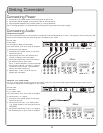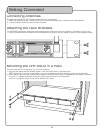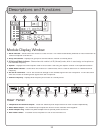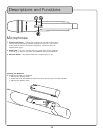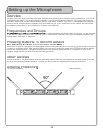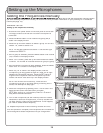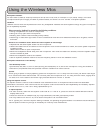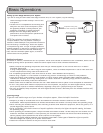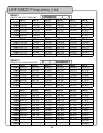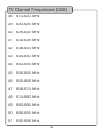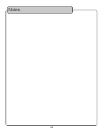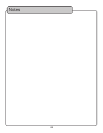
16
Using the Wireless Mics
Microphone Position
The UHF-5900 is ideal for close-up vocals and can be held in the hand or mounted on a mic stand. Keep in mind that
microphone technique is largely a matter of personal taste, and there is no one “correct” microphone position.
Feedback
Feedback occurs when the amplifi ed sound from any loudspeaker reenters the sound system through any open microphone
and is repeatedly amplifi ed.
Most commonly, feedback is caused by the following conditions:
•
Placing loudspeakers too close to microphones.
•
Having too many open active microphones.
•
Boosting tone controls indiscriminately (mainly treble).
•
Performing in areas with high ratios of room surfaces that have hard and refl ective surfaces such as glass, marble
and wood.
What to do if feedback occurs before the sound system is loud enough
:
•
Request that the talker speak louder into the microphone.
•
Reduce the distance from the talker to the microphone. Each time this distance is halved, the sound system output will
increase by 6dB.
•
Reduce the number of open microphones.
•
Move the loudspeaker farther away from the microphone. Each time this distance is doubled, the sound system output
can be increased by 6dB.
•
Move the loudspeaker closer to the listener.
•
Use an equalizer/feedback reducer to cut the frequency bands in which the feedback occurs.
Microphone Placement & Tone Quality
Lead & Backup Vocals
Lips should be less than 3” from or even touching the windscreen on an axis to the microphone. Doing this creates a
robust sound, emphasizes bass and provides maximum isolation from other sources.
Speech
When giving a speech or simply speaking, place the microphone 4” to 10” away from the mouth, just above nose height
for a natural sound with reduced bass. You can also place the microphone 8” to 16” away from the mouth, slightly off to
one side, for a more “distant” sound with highly reduced bass and minimal “s” sounds.
Using the Squelch control
The Squelch control is used to mute unwanted noise interference from a microphone channel when the associated
transmitter is turned off. Each channel has its own squelch control and should be set independently as necessary. Squelch
can be set from 0 to 15, with 10-15 being represented by A-F.
To adjust squelch:
•
For each channel, start with the squelch control set at ‘0’. If not at ‘0’, press and hold the DOWN ARROW until the
display reads ‘SQ 0’.
•
Press and hold the UP ARROW until any noise interference has been successfully muted.
• You may
need to turn the m
• You may need to turn the m• You may
ic on/off to test if the squelch is at a suffici
ent level.
NOTE: Typically, as a channel’s squelch setting increases, its operating range decreases. It is therefore recommended to
set the squelch control only as high as necessary to mute any noise interference.



